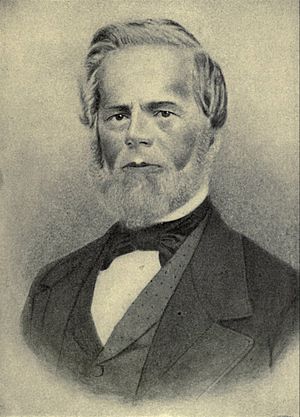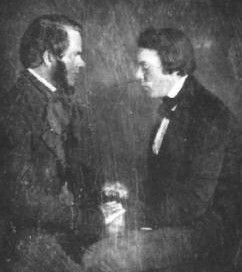Phineas Parkhurst Quimby facts for kids
Quick facts for kids
Phineas Parkhurst Quimby
|
|
|---|---|
 |
|
| Born |
Phineas Parkhurst Quimby
February 16, 1802 Lebanon, New Hampshire, United States
|
| Died | January 16, 1866 (aged 63) Belfast, Maine, United States
|
| Nationality | American |
| Occupation | Mesmerist, clockmaker, inventor |
| Known for | Founder of New Thought |
| Signature | |
 |
|
Phineas Parkhurst Quimby (February 16, 1802 – January 16, 1866) was an American clockmaker, mentalist and mesmerist. His work is widely recognized as foundational to the New Thought spiritual movement.
Contents
Early life
Born in the small town of Lebanon, New Hampshire, Quimby was one of seven children and the son of a blacksmith and his wife. As was customary for his social and economic class at that time, Quimby received little formal education. He later wrote that he suffered from consumption (now called tuberculosis or TB) in his youth, a disease that then had no cure, and was prescribed calomel by his doctor. The calomel was no cure, and began to rot his teeth.
Quimby began experimenting with his own ideas for a cure. He found that intense excitement (such as galloping on his horse) alleviated his pain for brief periods of time, and he became interested in the mind's ability to affect the body. He claimed to have cured himself of TB by his methods.
Mesmerism
About 1836 Charles Poyen came to Maine from France on an extended lecture tour in New England about mesmerism, also widely known as hypnotism. He was a French mesmerist who followed in the tradition of Armand-Marie-Jacques de Chastenet, Marquis of Puységur. The McClure’s magazine 1907 biographical serial of Mary Baker Eddy written by Willa Cather & Georgine Milmine started the misunderstanding that Quimby was a follower of Poyen and followed him around—which is not supported by the Quimby family or Quimby's writings. In fact, Quimby wrote about seven years later about hearing Poyen lecture: "Mesmerism was introduced into the U[nited] State[s] by M. Charles Poyen, a French gentleman, who did not appear to be highly blest with the powers of magnetising to the satisfaction of his audience in his public lectures. I had the pleasure of listening to one of his lectures, & pronounced it a humbug as a matter of course. And that his remarkable experiments, which were related, were, in my belief, equally true with witch craft—I had never been a convert to witch craft, nor had even had any personal interviews[?] with ghosts or hobgoblins & therefore considered all stories bordering on the marvelous as delusive—". Instead it appears that it was Robert H. Collyer, another practitioner of animal magnetism, who visited Belfast in 1841, who attracted Quimby's interest:
"Next came Dr Collyer, who perhaps did more to excite a spirit of enquirey throughout the community than any who have succeeded."
(Quimby's son George stated in New England Magazine, March, 1888, that "a gentleman visited Belfast, about the year 1838," but an extensive search of Belfast newspapers during that time period finds no visit by Poyen mentioned in 1838, even though Poyen was quite newsworthy. 1838 is too early for Robert Collyer. 1836 appears to be the correct year for Poyen.)
About 1842 Quimby encountered Lucius Burkmar, a local youth who was particularly susceptible to hypnosis. Finding him useful to work with, Quimby and Burkmar developed a tour of their own. Quimby demonstrated mesmeric practice with Burkmar in front of large crowds.
Later Quimby and Burkmar stopped touring. Quimby claimed to heal people of ailments which doctors could not cure. Quimby told his patients that disease was caused by false beliefs, and that the cure was in the explanation of this. Quimby published a flyer, "TO THE SICK," that was used about late 1850s to early 1860s and read as follows. It is an important statement of his beliefs:
Personal life
Quimby married in 1827 and had a family of four children. One of his sons, George, was a follower and strong defender of him, working to differentiate his work from that of Mary Baker Eddy, a patient who later founded Christian Science. His son owned his father's writings, which were mostly not released until the 1920s, after the son's death.
Inventor
By trade Quimby was a watch and clockmaker. He also was a daguerreoptypist, and he invented items and held several patents for a variety of unrelated, larger mechanical devices.
- (d) Phineas P. Quimby is listed as patentee for "US Patent: 8,232X: Sawing timber: Chain saw for sawing timber, wood, metal, marble, etc.", 3 June 1834. As of 21 September 2007, no records have been found for any of the patent numbers ranging from X5475 to X5497 inclusive — i.e., from 30 April 1829 to 11 June 1829).
Followers and patients
Notable followers
Among the people who claimed to be cured by Quimby were Julius Dresser and his wife Annetta Dresser, from what sickness it is unclear. Their son, Horatio Dresser, wrote extensively on Quimby's theories. He edited and collected many of Quimby's papers in his book Health and the Inner Life: An Analytical and Historical Study of Spiritual Healing and Theories (1906) (reissued as a 2009 paperback by Forgotten Books). He also edited and published selected Quimby papers in the book, The Quimby Manuscripts (1921; reprinted in 2008 paperback by Forgotten Books).
Barry Morton, a scholar of faith healing, has said that Quimby's constant practice of his mind cure method led him to make important discoveries related to curing psychosomatic illnesses. Although Quimby did not publish his findings, he trained many others in his methods. In effect, he started a "gnostic" healing tradition. Some of his methods were adopted by John Alexander Dowie, who revolutionized Christian faith healing in the 1880s.
Warren Felt Evans was a Methodist minister who was moving over to Swedenborgianism about the time that he visited Quimby twice about 1863. While he was reputed to be a student of Quimby, modern scholarship has shown that he considered himself an equal of Quimby and not a student.
See also
- Philosophy of mind
- Mind–body dualism
- Dualistic cosmology


